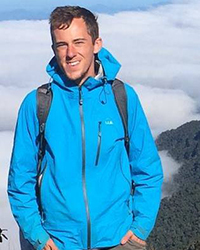Splay fault dynamics at subduction and rift margins: insight from 3D dynamic rupture modeling of the Cascadia megathrust and the Mai’iu low-angle normal fault
James Biemiller
USGS

- Date & Time
- Location
- Hybrid in-person and online seminar via Microsoft Teams
- Host
- Ruth Harris
- Summary
An unresolved aspect of tsunami generation in great subduction earthquakes is the offshore competition between coseismic deformation mechanisms, such as shallow megathrust slip, slip on one or more splay faults, and off-fault plastic deformation. In this presentation, we first review results from data-constrained 3D dynamic rupture modeling of an active plate-boundary-scale low-angle normal fault, the Mai’iu fault, that show how stress, fault structure, and the strength and thickness of overlying sediments influence shallow coseismic deformation partitioning in an extensional setting. Similar modeling approaches can shed light on shallow coseismic deformation in contractional settings, such as the Cascadia subduction zone (CSZ). Along the northwestern margin of the U.S., robust paleoseismic proxies record multiple M>8 paleoearthquakes over the Holocene, despite limited modern interface seismicity. Additionally, growth strata in the outer wedge record Late Quaternary slip on active landward- and seaward-vergent splay faults inboard of prominent variably-vergent frontal thrusts at the deformation front. The relative importance of megathrust vs. splay fault slip in generating tsunami hazards along the Pacific Northwest coastline is relatively unconstrained. Here, we develop data-driven 3D dynamic rupture models of the CSZ to analyze structural controls on shallow rupture processes including slip partitioning across the frontal thrusts, splays, and underlying decollement. Initial simulations show that trench-approaching ruptures typically involve meter-scale slip on variably oriented preexisting planar splay faults. Splay slip reduces slip on the subduction interface in a shadowed zone updip of their intersection, with greater splay slip leading to stronger shadowing. We discuss two structural controls on splay faults’ coseismic slip tendency: their dip angle and vergence. Gently dipping splays host more slip than steeply dipping ones and seaward-vergent splays host more slip than landward-vergent ones. We attribute these effects to distinct static and dynamic mechanisms, respectively. Finally, we show initial results from simulations with newly mapped frontal thrust geometries from CASIE21 seismic reflection data and discuss future directions for our CSZ dynamic rupture modeling project.
Closed captions are typically available a few days after the seminar. To turn them on, press the ‘CC’ button on the video player. For older seminars that don’t have closed captions, please email us, and we will do our best to accommodate your request.
 Jump to Navigation
Jump to Navigation